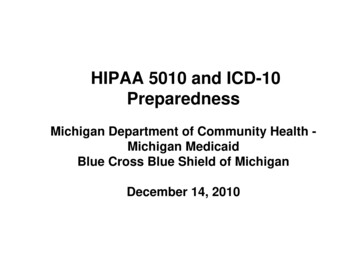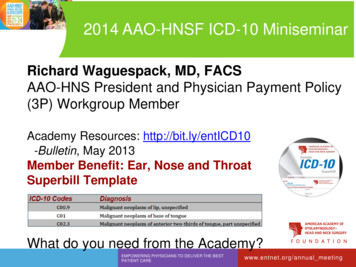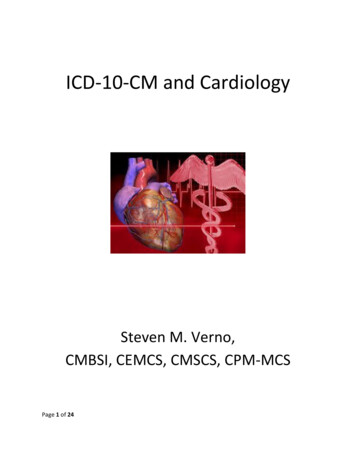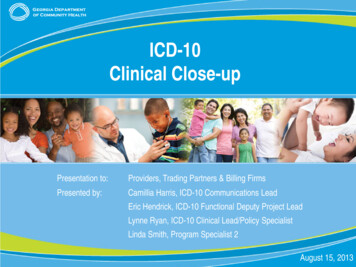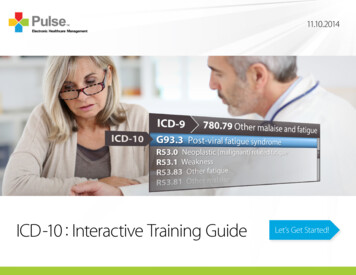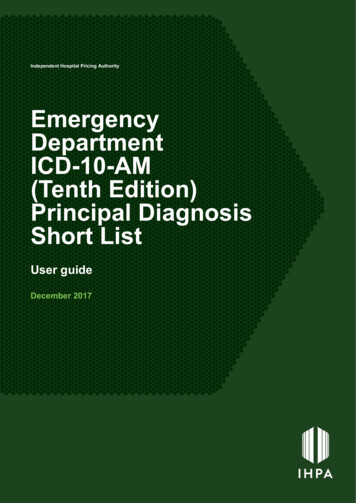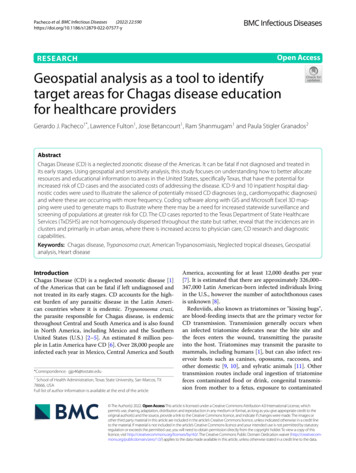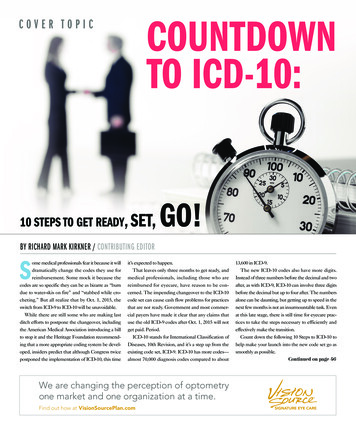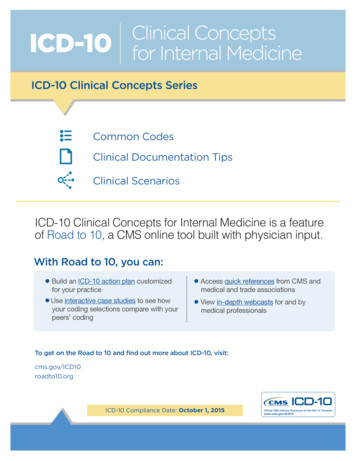
Transcription
ICD-10Clinical Conceptsfor Internal MedicineICD-10 Clinical Concepts SeriesCommon CodesClinical Documentation TipsClinical ScenariosICD-10 Clinical Concepts for Internal Medicine is a featureof Road to 10, a CMS online tool built with physician input.With Road to 10, you can:lBuild an ICD-10 action plan customizedfor your practicel Useinteractive case studies to see howyour coding selections compare with yourpeers’ codinglAccess quick references from CMS andmedical and trade associationslView in-depth webcasts for and bymedical professionalsTo get on the Road to 10 and find out more about ICD-10, visit:cms.gov/ICD10roadto10.orgICD-10 Compliance Date: October 1, 2015Official CMS Industry Resources for the ICD-10 Transitionwww.cms.gov/ICD101
Table Of ContentsCommon Codes Abdominal Pain Headache Acute Respiratory Infections Hypertension Back and NeckPain (Selected) Pain in Joint Chest Pain Diabetes Mellitus w/oComplications Type 2 General Medical Examination Pain in Limb Other Forms ofHeart Disease Urinary TractInfection, CystitisClinical Documentation Tips Acute MyocardialInfarction (AMI) Hypertension Asthma Underdosing Diabetes Mellitus,Hypoglycemia andHyperglycemia Abdominal Pain andTendernessClinical Scenarios Scenario 1: Follow-Up:Kidney Stone Scenario: CervicalDisc Disease Scenario 2: Epigastric Pain Scenario: Abdominal Pain Scenario 3: DiabeticNeuropathy Scenario: Diabetes Scenario 4: Poisoning Scenario: COPD with AcutePneumonia Example Scenario: ER Follow Up
Common CodesICD-10 Compliance Date: October 1, 2015Abdominal Pain (ICD-9-CM 789.00 to 789.09 31R10.32R10.33R10.84R10.9*Acute abdomenUpper abdominal pain, unspecifiedRight upper quadrant painLeft upper quadrant painEpigastric painPelvic and perineal painLower abdominal painRight lower quadrant painLeft lower quadrant painPeriumbilical painGeneralized abdominal painUnspecified abdominal pain*Codes with a greater degree of specificity should be considered first.3
Acute Respiratory Infections (ICD-9-CM 462, 465.9, 466.0)[Note: Organisms should be specified where 4J20.5J20.6J20.7J20.8J20.9*Acute pharyngitis due to other specified organismsAcute pharyngitis, unspecifiedAcute upper respiratory infection, unspecifiedAcute bronchitis due to Mycoplasma pneumoniaeAcute bronchitis due to Hemophilus influenzaeAcute bronchitis due to streptococcusAcute bronchitis due to coxsackievirusAcute bronchitis due to parainfluenza virusAcute bronchitis due to respiratory syncytial virusAcute bronchitis due to rhinovirusAcute bronchitis due to echovirusAcute bronchitis due to other specified organismsAcute bronchitis, unspecified*Codes with a greater degree of specificity should be considered first.Back and Neck Pain (Selected) (ICD-9-CM 723.1, 724.1, 724.2, 724.5)M54.2M54.5M54.6M54.89M54.9*CervicalgiaLow back painPain in thoracic spineOther dorsalgiaDorsalgia, unspecified*Codes with a greater degree of specificity should be considered first.4
Chest Pain (ICD-9-CM 786.50 to 786.59 range)R07.1R07.2R07.81R07.82R07.89R07.9*Chest pain on breathingPrecordial painPleurodyniaIntercostal painOther chest painChest pain, unspecified*Codes with a greater degree of specificity should be considered first.Diabetes Mellitus w/o Complications Type 2 (ICD-9-CM 250.00)E11.9Type 2 diabetes mellitus without complicationsGeneral Medical Examination (ICD-9-CM V70.0)Z00.00Z00.01Encounter for general adult medical exam without abnormal findingsEncounter for general adult medical exam with abnormal findingsHeadache (ICD-9-CM 784.0)R51HeadacheHypertension (ICD-9-CM 401.9)I10Essential (primary) hypertension5
Pain in Joint (ICD-9-CM 719.40 to 719.49 1M25.562M25.569*M25.571M25.572M25.579*M25.50*Pain in right shoulderPain in left shoulderPain in unspecified shoulderPain in right elbowPain in left elbowPain in unspecified elbowPain in right wristPain in left wristPain in unspecified wristPain in right hipPain in left hipPain in unspecified hipPain in right kneePain in left kneePain in unspecified kneePain in right ankle and joints of right footPain in left ankle and joints of left footPain in unspecified ankle and joints of unspecified footPain in unspecified joint*Codes with a greater degree of specificity should be considered first.6
Pain in Limb (ICD-9-CM 672M79.673*M79.674M79.675M79.676*Pain in right armPain in left armPain in arm, unspecifiedPain in right legPain in left legPain in leg, unspecifiedPain in unspecified limbPain in right upper armPain in left upper armPain in unspecified upper armPain in right forearmPain in left forearmPain in unspecified forearmPain in right handPain in left handPain in unspecified handPain in right finger(s)Pain in left finger(s)Pain in unspecified finger(s)Pain in right thighPain in left thighPain in unspecified thighPain in right lower legPain in left lower legPain in unspecified lower legPain in right footPain in left footPain in unspecified footPain in right toe(s)Pain in left toe(s)Pain in unspecified toe(s)*Codes with a greater degree of specificity should be considered first.7
Other Forms Of Heart Disease (ICD-9-CM 427.31)I48.0I48.2I48.91*Paroxysmal atrial fibrillationChronic atrial fibrillationUnspecified atrial fibrillation*Codes with a greater degree of specificity should be considered first.URINARY TRACT INFECTION, CYSTITIS (ICD-9-CM 595.0 TO 595.4RANGE, 595.81, 595.82, 595.89, 595.9, e cystitis without hematuriaAcute cystitis with hematuriaInterstitial cystitis (chronic) without hematuriaInterstitial cystitis (chronic) with hematuriaOther chronic cystitis without hematuriaOther chronic cystitis with hematuriaTrigonitis without hematuriaTrigonitis with hematuriaIrradiation cystitis without hematuriaIrradiation cystitis with hematuriaOther cystitis without hematuriaOther cystitis with hematuriaCystitis, unspecified without hematuriaCystitis, unspecified with hematuriaUrinary tract infection, site not specified*Codes with a greater degree of specificity should be considered first.8
Primer for Internal Medicine ClinicalDocumentation ChangesICD-10 Compliance Date: October 1, 2015Specifying anatomical location and laterality required by ICD-10 is easier than you think. This detail reflects howphysicians and clinicians communicate and to what they pay attention - it is a matter of ensuring the information iscaptured in your documentation.In ICD-10-CM, there are three main categories of changes: Definition Changes Terminology Differences Increased SpecificityOver 1/3 of the expansion of ICD-10 codes is due to the addition of laterality (left, right, bilateral). Physicians and otherclinicians likely already note the side when evaluating the clinically pertinent anatomical site(s).ACUTE MYOCARDIAL INFARCTION (AMI)Definition ChangeWhen documenting an AMI, include the following:1. TimeframeAn AMI is now considered “acute” for 4 weeks from the time of the incident.2. Episode of careICD-10 does not capture episode of care (e.g. initial, subsequent,sequelae).3. Subsequent AMIICD-10 allows coding of a new MI that occurs during the 4 week “acuteperiod” of the original AMI.ICD-10 Code ExamplesI21.02I21.4I22.1ST elevation (STEMI) myocardial infarction involving left anteriordescending coronary arteryNon-ST elevation (NSTEMI) myocardial infarctionSubsequent ST elevation (STEMI) myocardial infarction9
HYPERTENSIONDefinition ChangeIn ICD-10, hypertension is defined as essential (primary). The concept of “benign or malignant” as it relates tohypertension no longer exists.When documenting hypertension, include the following:1. Typee.g. essential, secondary, etc.2. Causal relationshipe.g. Renal, pulmonary, etc.ICD-10 Code ExamplesI10I11.9I15.0Essential (primary) hypertensionHypertensive heart disease without heart failureRenovascular hypertensionASTHMATerminology DifferenceICD-10 terminology used to describe asthma has been updated to reflect the current clinical classification system.When documenting asthma, include the following:1. CauseExercise induced, cough variant, related to smoking, chemical orparticulate cause, occupational2. SeverityChoose one of the three options below for persistent asthma patients1. Mild persistent2. Moderate persistent3. Severe persistent3. Temporal FactorsAcute, chronic, intermittent, persistent, status asthmaticus,acute exacerbationICD-10 Code ExamplesJ45.30J45.991Mild persistent asthma, uncomplicatedCough variant asthma10
UNDERDOSINGTerminology DifferenceUnderdosing is an important new concept and term in ICD-10. It allows you to identify when a patient is taking lessof a medication than is prescribed.When documenting underdosing, include the following:1. Intentional, Unintentional,Non-complianceIs the underdosing deliberate? (e.g., patient refusal)2. ReasonWhy is the patient not taking the medication?(e.g.financial hardship, age-related debility)ICD-10 Code ExamplesZ91.120Patient’s intentional underdosing of medication regimen due tofinancial hardshipT36.4x6AUnderdosing of tetracyclines, initial encounterT45.526DUnderdosing of antithrombotic drugs, subsequent encounter11
DIABETES MELLITUS, HYPOGLYCEMIA AND HYPERGLYCEMIAIncreased SpecificityThe diabetes mellitus codes are combination codes that include the type of diabetes mellitus, the body systemaffected, and the complications affecting that body system.When documenting diabetes, include the following:1. Typee.g. Type 1 or Type 2 disease, drug or chemical induces, due to underlyingcondition, gestational2. ComplicationsWhat (if any) other body systems are affected by the diabetes condition? e.g. Footulcer related to diabetes mellitus3. TreatmentIs the patient on insulin?A second important change is the concept of “hypoglycemia” and “hyperglycemia.” It is now possible to documentand code for these conditions without using “diabetes mellitus.” You can also specify if the condition is due to aprocedure or other cause.The final important change is that the concept of “secondary diabetes mellitus” is no longer used; instead, there arespecific secondary options.ICD-10 Code ExamplesE08.65Diabetes mellitus due to underlying condition with hyperglycemiaE09.01Drug or chemical induced diabetes mellitus withhyperosmolarity with comaR73.9Transient post-procedural hyperglycemiaR79.9 Hyperglycemia, unspecified12
ABDOMINAL PAIN AND TENDERNESSIncreased SpecificityWhen documenting abdominal pain, include the following:1. Locatione.g. Generalized, Right upper quadrant, periumbilical, etc.2. Pain or tenderness typee.g. Colic, tenderness, reboundICD-10 Code ExamplesR10.31R10.32R10.33Right lower quadrant painLeft lower quadrant painPeriumbilical pain13
Clinical ScenariosICD-10 Compliance Date: October 1, 2015Quality clinical documentation is essential for communicating the intent of an encounter, confirming medical necessity,and providing detail to support ICD-10 code selection. In support of this objective, we have provided outpatient focusedscenarios to illustrate specific ICD-10 documentation and coding nuances related to your specialty.The following scenarios were natively coded in ICD-10-CM and ICD-9-CM. As patient history and circumstances willvary, these brief scenarios are illustrative in nature and should not be strictly interpreted or used as documentation andcoding guidelines. Each scenario is selectively coded to highlight specific topics; therefore, only a subset of the relevantcodes are presented.Scenario 1: Follow-Up: Kidney StoneScenario DetailsChief Complaint Follow-up from encounter 2 days ago, review results of tests1.History 87 year old female with right lower back / flank pain (described as dull, achy and does not goaway)3, nausea, vomiting for 6 days. Daughter is present. Medical history significant for renal stones, diverticulitis, and Alzheimer’s dementia2. Patient lives with daughter who reports blood tinged urine.Exam Patient was seen in office earlier with similar symptoms – blood in urine, pain.Increased tenderness in lower right flank area noted. Bladder mildly distended.VS normal, afebrile.Lab results reviewed; creatinine is 1.48. BUN is 32, both elevated from baseline. Urine resultsshow gross blood without signs of infection. Chest film clear.14
Scenario 1: Follow-Up: Kidney Stone (continued)Assessment and Plan Right renal calculi3. Reviewed laboratory evaluation results and CT results. Treatment optionsdiscussed with daughter and patient. Admit orders written to include nephrologist consult. IVF (NS) started in office. EMS called; patient was transported to the hospital.Summary of ICD-10-CM ImpactsClinical Documentation1. Documenting why the encounter is taking place is important, as the coder may assign adifferent code based on the type of visit and the intent (e.g., screening, with no complaint orsuspected diagnosis, for administrative purposes). In this situation, the patient is consultingfor an explanation of test findings from a previous visit but her clinical condition presents as akidney stone.2. If known be sure to specify the type of dementia. Also document any behavioral disturbancesif present. Since the dementia is relevant to this patient’s care and can affect the outcome oftreatment it is coded.3. There is no specific code for flank pain or abdominal wall pain. The flank pain should becoded to “other abdominal pain” since the pain is specific to a site location. In other clinicaldocumentation presentations, lumbago or another code could be relevant. In this specific note,as the pain is associated with the underlying medical condition of the renal calculi, the paincodes are not listed per the official coding guidelines.CodingICD-9-CM Diagnosis Codes592.Ø331.0Calculus of kidneyAlzheimer’s diseaseV65.8Other reasons for seekingconsultationICD-9-CM Diagnosis CodesN20.0Calculus of kidneyG30.9Alzheimer’s disease,unspecifiedZ71.2Person consulting forexplanation of examinationor test findingsOther Impacts Be sure to document the medical necessity of this visit in the history, assessment, and plan. With the implementation of ICD-10-CM reassess the data collection and documentation of thechief complaint as described by the patient, and recorded in the medical record.15
Scenario 2: Epigastric PainScenario DetailsChief Complaint “My chest has been burning for three days.”History 83 year old female with history of chronic left-sided congestive heart failure1, well controlled,CAD, mild intermittent asthma, depression, type II diabetes2, and GERD4. Patient experiencing burning to center of chest and throat with some occasional nausea. Shegenerally avoids spicy foods but ate Mexican meal with her friends 3 days ago. Took a friend’snitroglycerin SL tablet, but symptoms did not improve. Has been taking over-the-counterantacids to relieve symptoms. She finds that sleeping on three pillows lessons burning symptoms; symptoms worsen whensleeping on left side. Denies SOB or worsening of CHF symptoms. Notes bitter taste in mouthat times. Diabetes is well controlled with subcutaneous insulin. Patient reports blood glucose is between90 and 110. Intermittent asthma is well controlled3, unaffected by presenting symptoms.Exam Chest clear. Heart sounds normal.EKG shows no changes from prior, does show left ventricular hypertrophy.CXR is unchanged from previous.Abdomen is soft, non-tender to exam except to epigastric area. No guarding.Vitals: BP is 112/60, HR is 65, O2 saturation is 99% on room air. No fever noted.Assessment and Plan GERD4 Modify diet to avoid spicy foods, alcohol. Avoid eating three hours before bedtime. Continuesleeping with head of bed elevated until symptoms subside. Continue OTC antacid per label instructions to control symptoms Begin esomeprazole 20 mg PO daily x 4 weeks. Follow up in four weeks if symptoms not improved.16
Scenario 2: Epigastric Pain (continued)Summary of ICD-10-CM ImpactsClinical Documentation1. Document the acuity (i.e., chronic, acute, acute on chronic) and type (i.e. systolic, diastolic orboth) of heart failure, as there are discrete ICD-10-CM codes for each type.2. Document the type of diabetes and if appropriate, any effects due to the disease (e.g. a footulcer, diabetic retinopathy, etc.).3. If asthma symptoms were present, then the provider should note whether or not the asthmais persistent, triggers (if known) how many attacks per day, week or month are typicallyexperienced, and the functional impact. ICD-10 does not include the concept of extrinsic orintrinsic as represented in ICD-9-CM. In ICD-10-CM one must document whether asthmais mild intermittent, persistent, or moderate and severe persistent. Furthermore, ICD-10-CMguidelines now require the use of an additional code to indicate if a patient is exposed totobacco smoke.4. In ICD-10-CM, gastroesophageal reflux disease is differentiated by noting “with esophagitis”(K21.0) versus “without esophagitis” (K21.9). As there is no documentation under the physicalexam noting that esophagitis was evident gastroesophageal reflux disease without esophagitisis coded.CodingICD-9-CM Diagnosis Codes530.81Esophageal reflux428.1Left heart failure250.00Diabetes mellitus typeII without complicationsnot stated as uncontrolledV58.67Long-term use of insulin493.10Intrinsic asthma,unspecifiedICD-10-CM Diagnosis CodesK21.9Gastro-esophageal reflux diseasewithout esophagitisI50.1Left ventricular failureE11.9Type 2 diabetes mellitus withoutcomplicationsZ79.4Long term (current) use of insulinJ45.20Mild intermittent asthma,uncomplicatedOther ImpactsManagement of chronic conditions such as diabetes, asthma or heart failure should be described in therecord. The documentation of the clinical management may lead to increased reimbursement via clinicalquality measures, or quality improvement pay-for-performance physician incentives, regardless of clinicalpresentation/complications.17
Scenario 3: Diabetic NeuropathyScenario DetailsChief Complaint Right heel ulcer.History This 41-year-old male, established patient with Type I diabetes mellitus. He presents today witha new wound to his right heel and a contusion wound that is slow to heal on his right shin. The patient states he discovered the right heel ulcer 5 days ago when he noticed his sock wassoiled in the heel area. The contusion wound to his right shin occurred five weeks ago frombumping into furniture and it does not seem to be healing. Past Medical History: Type I diabetes mellitus, diagnosed at age 12; bilateral lower extremityperipheral neuropathy diagnosed at age 37; hypoglycemic episodes and nephropathy. Diet and Activity: Patient has no concerns about diet. Patient routinely exercises three days aweek. Medications: NPH and Regular insulin. He states he regulates his blood sugars based on howhe feels, and admits he rarely checks his blood sugar with a glucometer. Denies smoking, alcohol and drug use. Laboratory evaluation significant for A1c 11.9; Microalbumin 105.Exam Vital Signs: BP 122/88 Pulse 104 RR 18 T 98.5 Finger stick BS 150 mg/dL.Well nourished, well-groomed, A&Ox3.HEENT & Neck: no visual disturbances, otherwise normal to exam.Respiratory: lungs clear to auscultation.Cardiac: RRR No murmurs, rubs or gallops.Abdomen: soft and nontender, no masses.Neuro: Significant for lower extremity numbness throughout. Bottom of right foot has a 1 cmheel ulcer. There is a small contusion on right shin, 2 cm by 1 cm, healing poorly with no signsof infection. CN II-XII grossly intact. Normal ambulation.Assessment and Plan Worsening neuropathy with foot ulcer and slow healing shin wound. Will debride and treat wounds here and refer to Wound Care Center for ongoing care andmanagement. Discussed importance of foot care, and the need to routinely inspect lower legs and bottoms offeet because of the bilateral peripheral neuropathy. Counseled patient about the importance of tight, stable glycemic control to slow theprogression of neuropathy and nephropathy; advised to keep a log of his blood sugars for twoweeks for our review.18
Scenario 3: Diabetic Neuropathy (continued)Summary of ICD-10-CM ImpactsCodingComplicated wounds in ICD-9-CM are classified as “complicated” when they include “delayed healing”.ICD-10-CM does not make that “complicated” differentiation. Type I diabetes in ICD-10-CM does notutilize the Z79.4 use of insulin for Type I diabetes. The Z code Z79.4 (insulin use) is used with E08, E09,E11, E13, O24.1-, O24.3-, O24.8-, and O24.9- diabetes categories of ICD-10-CM.ICD-9-CM Diagnosis Codes250.61357.2Diabetes with neurologicalmanifestations, type I [juveniletype], not stated as uncontrolledPolyneuropathy in diabetes250.81Diabetes with other specifiedmanifestations, type I [juveniletype], not stated as uncontrolled(ulcer, heel)707.14Ulcer of heel and midfoot250.51583.81Diabetes with renalmanifestations, type I, [juveniletype], not stated as uncontrollednephropathy, NOSICD-10-CM Diagnosis CodesE10.42Type 1 diabetes mellitus withdiabetic polyneuropathyE10.621Type 1 diabetes mellitus withfoot ulcerL97.411Non-pressure chronic ulcer ofright heel and midfoot limitedto breakdown of skinE10.21Type I diabetes mellitus ified open wound, rightlower leg, initial episode791.0Proteinuria891.1Wound, lower leg,complicatedV58.67Long-term (current) use ofinsulinOther ImpactsNo specific impact noted.19
Scenario 4: PoisoningScenario DetailsChief Complaint Sudden onset of agitation, palpitations, diarrhea, heavy sweating, fever with shivering, andfeeling “out of it” after taking OTC cough medicine.History 45 year old male patient, is a tractor trailer driver, and states he took dextromethorphan sixdays ago to help with his cough while on the road. Soon after, he began to have sudden onsetof irritability/agitation, palpitations, diarrhea, diaphoresis, fever with shivering, and feeling “outof it”. Current medication: Duloxetine hydrochloride, prescribed by his psychiatrist three weeksago for depression and generalized anxiety disorder; he has had no side effects from thatmedication until now. Patient states he stopped taking both medications the first day, mostsymptoms resolved within 24 hours, and were totally resolved by 96 hours. Feels fine now onday six. No significant recent stressors. Wife present with patient.No family history of any mental or behavioral illness.Denies smoking, alcohol and illicit drug use.Allergies: NKDA.Exam Vital Signs: Normal. NEURO: A&Ox3, affect is appropriate, Patient exhibits coherent, logical thought process. Hestates he would like to discontinue taking the duloxetine hydrochloride. HEENT & NECK: Normal findings. Respiratory: Clear to auscultation with normal respiratory effort. Cardiac: Normal findings. Abdomen: Normal findings.Assessment and Plan Symptoms resolved. Discussed case with patient’s psychiatrist, including patient’s desire to discontinue medication. Psychiatrist will see patient in his office in 2 days for medication re-evaluation. Counseled patient on the importance of not discontinuing his antidepressant medicationabruptly, and to consult with his psychiatrist before taking OTC drugs, and supplements. No additional treatment or supportive care necessary at this time. No labs ordered at this time.20
Scenario 4: Poisoning (continued)Summary of ICD-10-CM ImpactsClinical Documentation1. The ICD-10 framework provides a single code to document the poisoning/toxic effect of substances and whether the poisoning was intentional. The 7th character of the ICD-10-CM code(T43.211A) specifies the visit is an initial patient encounter.2. Poisoning is classified [according to the ICD-10-CM Official Guidelines for Coding and Reporting] if a non-prescribed drug or medicinal agent is taken in combination with a correctly prescribed and properly administered drug, any drug toxicity or other reaction resulting from theinteraction of the two drugs.3. Additional code(s) are used to document manifestations of the poisoning.CodingUnderdosing by Z91.12- and Z91.23- reference is found at the beginning of T36-T50 category in theTabular List (Volume 1)ICD-9-CM Diagnosis Codes969.02Poisoning by selectiveserotonin and norepinephrinereuptake inhibitorE854.0Accidental poisoning byantidepressants975.4Poisoning by antitussivesE858.6Accidental poisoning by agentsprimarily acting on the smoothand skeletal muscles andrespiratory a780.8Generalized hyperhidrosis780.60Fever, unspecified780.97Altered mental status799.29RestlessnessICD-10-CM Diagnosis CodesT43.211APoisoning by selectiveserotonin and norepinephrinereuptake inhibitors, accidental(unintentional), initial encounterT48.3X1APoisoning by antitussives,accidental (unintentional), initialencounterR45.1Restlessness and agitation(Combination Z91.128Diarrhea, unspecifiedGeneralized hyperhidrosisFever, unspecifiedDisorientation, unspecifiedDepressionAnxietyPatient’s intentionalunderdosing of medicationregimen for other ce with medicaltreatmentOther ImpactsNo specific impact noted.21
Scenario: COPD with Acute Pneumonia ExampleScenario DetailsChief Complaint “I just got out of the hospital 2 days ago. I’m a little better, but still can barely breathe.”History 67-year-old male with 40 pack/year history of cigarette use (still smoking) and severe oxygendependent COPD developed cough with increased production of green/gray sputum 2 weeksprior to office visit. Admitted to hospital through Emergency Department with diagnosis ofpresumed pneumonia superimposed on severe COPD. Hospital exam confirmed acute RLLpneumococcal pneumonia. Patient treated with an IV cephalosporin as he has known penicillinallergy, and was discharge from hospital to home 2 days prior to office visit. PMH shows severe O2 dependent COPD, with type II diabetes mellitus secondary to chronicprednisone therapy, which is treated with oral hypoglycemics. Patient also has knownhypertension, on ACE inhibitor therapy.Review of Systems, Physical Exam, Laboratory Tests T 99, BP 145/105, P 92 and irregular, RR 28 Chest exam shows decreased lung sounds throughout all lung fields except in RLL where therewere mild rhonchi and wheezes noted ABG’s on 2L O2 by nasal cannula show PO2 62, PCO2 47, pH 7.40 CXR shows hyperinflation of lungs with small RLL alveolar infiltration. Comparison to CXR fromhospitalization shows approximately 75% resolution of pneumonia. ECG reveals persistent atrial fibrillation which was not present on previous ECG of 6 monthsearlier, but had been found at time of recent hospitalization. Labs show finger stick glucoseof 195mg%.Assessment and Plan Acute Community Acquired Pneumococcal Pneumonia: continue oral cephalosporin. Scheduleoffice follow up visit in 1 week with repeat CXR. Severe COPD: continue O2, low dose Prednisone, and inhaled bronchodilator. Chronic Hypoxemic, Hypercarbic Respiratory Failure Persistent Atrial Fibrillation: continue digoxin initiated during recent hospitalization Hypertension: continue ACE inhibitor therapy Diabetes Mellitus, Type II, secondary to prednisone therapy; continue oralhypoglycemic therapy Penicillin Allergy Tobacco Dependence22
Scenario: COPD with Acute Pneumonia Example (continued)Summary of ICD-10-CM ImpactsClinical Documentation ICD-10-CM separates pneumonia by infectious agent. Document the infectious agent of pneumonia, as there are discrete ICD-10-CM codes for each type. ICD-10-CM separates by acuity of respiratory failure, and hypoxia or hypercapnia, if present. Document drug allergies with ICD-10-CM status” Z” codes from Chapter 21 to identify these. Document the type of cardiac arrhythmia. Atrial fibrillation in ICD-10-CM separates into paroxysmal, persistent, chronic, typical, atypical, unspecified. Acute atrial fibrillation defaults tounspecified in ICD-10-CM. The Table of Drugs & Chemicals has a code assignment for Adverse effect of the drug thatwould be followed by the secondary diabetes code. Go to the Volume 3 Index to Table of Drugsand Chemicals. Along the left hand side proceed alphabetically to “Glucocorticoids” and thenmove horizontally across to the column for Adverse Effect”. In Volume 1 (Tabular List) the instruction at the beginning of the code category T38 are the instructions for the 7th character. Note: Drug-induced Diabetes Mellitus is a secondary type of diabetes due to the use of glucocorticoids. This code can only be coded as an “additional code” and would never be first-listedThe code categories for secondary diabetes are : Due to underlying disease (E08) Due to drug (E09) Due to other specified condition such as post pancreatectomy. (E13)These three categories can never be first-listed per ICD-10-CM guidelines. The underlying causewould be first-listed diagnosis.CodingICD-9-CM Diagnosis Codes481Pneumonia, Pneumococcal496COPDV46.2Oxygen dependence427.31Atrial fibrillation249.00Diabetes, secondary, druginducedE932.0Therapeutic use of Prednisone401.9V14.0305.1HTNAllergy, PenicillinTobacco dependenceICD-10-CM Diagnosis CodesJ13Pneumonia due toStreptococcus pneumoniaeJ44.0Chronic obstructive pulmonarydisease with acute lowerrespiratory infectionZ99.81Dependence on supplementaloxygenI48.1Persistent atrial fibrillationE09.9Drug or chemical induceddiabetes mellitus withoutcomplicationsT38.0x5AAdverse effect of glucocorticoidsand synthetic analogues, initialencounterI10Essential (primary) hypertensionZ8
ICD-10 Clinical Concepts Series. ICD-10 Clinical Concepts for Internal Medicine is a feature . of . Road to 10, a CMS online tool built with physician input. . Back and Neck Pain (Selected) (ICD-9-CM 723.1, 724.1, 724.2, 724.5) *Codes with a greater degree of specificity should be considered first.
